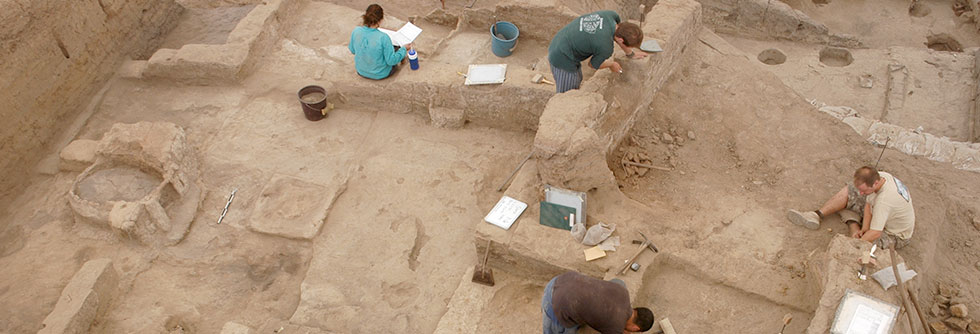
A Turkish UNESCO World Heritage Site inhabited thousands of years ago will help to unlock a greater understanding of the human story, thanks to a new collaborative research project led by experts from the University of Stirling and Stanford University.
Alex Bayliss, Professor of Archaeological Science at Stirling, will use radiocarbon dating to unravel the history of the Neolithic village at Çatalhöyük East in a joint £250,000 project with Ian Hodder, Dunlevie Family Professor of Anthropology at Stanford.
The Arts and Humanities Research Council (AHRC) and the National Science Foundation (NSF) have commissioned the five-year study at the 13 hectare mud brick site, said to date from 7100BC - 5900BC.
Professor Bayliss, from the School of Natural Sciences, said: "Precise chronology is vitally important as it allows archaeological evidence to be used by anthropologists and prehistorians to write historical narratives that are otherwise impossible.
"By scientifically attaching an age to the ancient Çatalhöyük East site in central Turkey, we will be able to explore and understand historical processes in more detail. For example, how long it took for innovations like pottery and milking to become widespread practices, and whether these were adopted in specific revolutions or by a slow constant stream of change.
"Key questions such as how the earliest settled communities were organised, and how they responded to climate change, can be addressed. We will also investigate the beliefs and rituals of early farmers, for example by tracing the history of specific animal reliefs and art motifs within the home.
"The Neolithic time capsule at Çatalhöyük East is pivotal for our understanding of these and many other major cogs in the human story. For example, the development and spread of early farming, the emergence of religion, and the conditions that allowed the growth of urbanism.
"Our results should have impact across discussion of early societies in the Middle East and beyond."
The project starts in August as part of the wider Çatalhöyük Research Project, which is directed by Ian Hodder with permission from the Turkish Ministry of Culture and Tourism.
Co-investigator Professor Hodder said: "This grant will allow us to write history in prehistory. By combining the very high-resolution results from a 25 year excavation project at Çatalhöyük with advances in radiocarbon dating we will be able to explore specific moments in the long process by which humans settled down, formed large villages and domesticated animals.
"For example, at Çatalhöyük we will be able to examine closely the process by which domestic cattle were adopted, and examine the specific events that led up to this momentous event in human development.
"We can also examine the specific moment at which cooking pottery was first used, unlocking the specific conditions that led up to this transformative moment.
"Archaeologists normally have to look at the distant past with a blurred vision, uncertain of the exact dates at which things occur. The new grant allows us to put on glasses so that we can see more clearly, even at events that took place 9000 years ago."
The radiocarbon dating will focus on Neolithic items from the site’s East Mound, with samples likely to include animal and human bones, charred plant remains and food crusts found on ceramic shards.
A book will be published of the research, and a computer animation showing the development of the site will be made available online.
Media enquiries to: Esther Hutcheson, Communications Officer, on 0044 (0)1786 466640 or email e.l.hutcheson@stir.ac.uk
Notes for editors
- Background information
Çatalhöyük is a UNESCO World Heritage site in central Turkey which attracts more than 25,000 annual visitors. It was first excavated in the 1960s and new excavations have continued since 1993. In addition to well-preserved mud-brick architecture it boasts dramatic wall paintings and relief sculpture. www.catalhoyuk.com
University of Stirling funding from the Arts & Humanities Research Council (AHRC) will enable a specialist in the structural sequence at Çatalhöyük to join Professor Bayliss.
This is the first funding award made by the AHRC as lead agency under the Memorandum of Understanding with NSF.
The Arts and Humanities Research Council (AHRC) funds world-class, independent researchers in a wide range of subjects: ancient history, modern dance, archaeology, digital content, philosophy, English literature, design, the creative and performing arts, and much more. This financial year the AHRC will spend approximately £98m to fund research and postgraduate training in collaboration with a number of partners. The quality and range of research supported by this investment of public funds not only provides social and cultural benefits but also contributes to the economic success of the UK. www.ahrc.ac.uk
The National Science Foundation (NSF) is an independent federal agency that supports fundamental research and education across all fields of science and engineering. In fiscal year (FY) 2015, its budget is $7.3 billion. NSF funds reach all 50 states through grants to nearly 2,000 colleges, universities and other institutions. Each year, NSF receives about 48,000 competitive proposals for funding, and makes about 11,000 new funding awards. NSF also awards about $626 million in professional and service contracts yearly. www.nsf.gov
